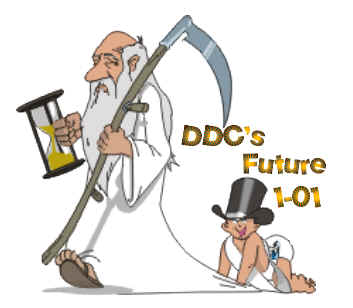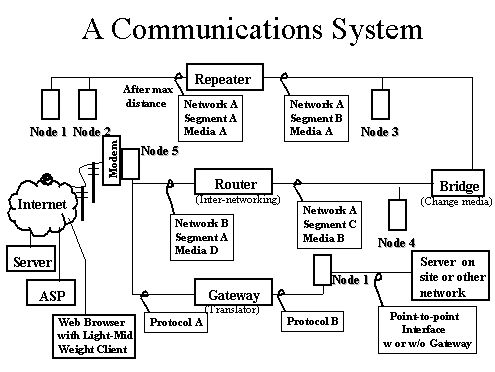
AutomatedBuildings.com
|
[an error occurred while processing this directive] |

John J. "Jack" Mc
Gowan, CEM
Contributing Editor
This month's Automator theme is "the future of controls" from the vantage point of this first month of 2001. As with nearly every other industry on the planet, the future of this business is directly linked with the World Wide Web. In fact the Web may have more to do with defining DDC's future than any individual development in control theory, HVAC or building technology.
In a recent article I talked about control synthesis. This is the concept that control specialties, which at one time spawned complete niche markets, such as DDC, SCADA and Process Control, are beginning to meld together. This is happening because technological obstacles to having one system meet the needs of these various specializations are breaking down. This does not mean that customers needs are becoming more generic, it means that System Integration and off the shelf technology that can be imported from the "Information Technology" (IT) world allows for one provider to combine the right set of products to meet those needs. At the same time there is a drive toward standardization on technology, and with advances in computing power and processing speed as well as data communication technology, integration is the optimal solution. At the heart of this trend is the World Wide Web. Consider that in Europe, many soft drink machines are already web-enabled via wireless automation protocol technology. If it is possible to buy a soft drink with your cell phone as shown in figure 1, what must be possible with buildings.

[an error occurred while processing this directive]The Web acts as a catalyst for accelerating this process, because technologies for all businesses from law to retailing to energy management are converging on the Web and taking advantage of the market potential that it represents. The focus of this article is to consider how some of these trends will change the control offering as well as the delivery of that offering. This rather complex topic will be summarized under three headings: control trends, Interface trends and system integration. In each category, the Web is helping to redefine our business. Trends in Deregulation and E-commerce are also presenting significant opportunities to grow the core control business as well. For example, the latest business projections from Forrester Research, a Cambridge MA based firm that tracks technology markets, project that e-commerce transactions to sell electricity will reach $250 billion in the United States by 2004. If you talk to the companies that are positioned to sell that power however, they are selling more energy services right now that energy. John Howell of eBidenergy.com says that a major portion of his business today is helping customers to build electricity consumption profiles so that they will know how much power they need and when they need it. The premise here is: what better way is there to build a profile and develop effective programs to both buy and manage energy than to implement a well designed DDC system?
Control Trends
There are a number of exciting trends in the area of controls, but in fact a large percentage of the activity is really in the system integration area. Though there is movement in some areas toward personal computer based hardware for DDC, custom microprocessor based controllers are still, and will likely continue to be the norm In some cases these are being called embedded devices and as they must be able to operate in sometimes harsh environments it is likely that equipment controllers will continue to consist of dedicated hardware. This is also likely to continue as well in the HVAC industry, because of the proliferation of manufacturer-developed controllers that are shipped from the factory, and may be capable of meeting several different data communication standards. The real activity is how these devices integrate to a higher level enterprise system, and how systems interact with one another.
Data communication will be discussed in further detail below, but before that it is important to highlight control-specific trends. There is considerable work underway to bring long-awaited self-learning control algorithms to the market. Utilizing adaptive control loops that can "learn" to operation more effectively and efficiently based upon changing building and climate conditions has long been of interest to the industry. At the same time there are indications that smart sensors and smart actuators may soon become more cost effective as well. Perhaps one of the most pervasive trends over the last decade has been the expansive implementation of data communication technology with DDC systems. The diagram below shows an example of how the communication architecture for a typical DDC system is evolving to look. Much of the terminology is becoming more familiar because it shows up in advertisements. The diagram does not focus on any specific standard, in fact it assumes that multiple protocols are being blended, perhaps in the expansion of an existing system. In spite of the protocol, many of these devices will still be common as well, such as repeaters and bridges. Repeaters, which amplify the signal to allow devices to be installed over a longer run of wire, are often needed in large buildings. As it has become common to use different types of wiring, or media, in many systems, bridges are need to combine different media such as coax and twisted pair. Gateways are common as well to act as translators between systems that speak different protocols. Enterprise systems will usually require gateways to allow legacy (existing) systems to communicate with new systems. Finally the latest trend is the interface of the current DDC or enterprise system with the World Wide Web via a server or Application Service Provider (ASP).

Interface
The Web will have a revolutionary impact on the way the owners manage facilities and interface with DDC systems and building equipment. The benefit goes far beyond interface, though that is a key focus of this section. The introduction of complete Web Browser packages along with the ability of System Integrators to adapt any system for interface via light-weight client software, such as Netscape Navigator, could have a revolutionary impact on interface. In most cases this requires that a dedicated server to reside on site with the DDC system to allow for this interface to occur. Another option is for the server to reside at another location in the form of an Application Service Provider that will communicate with all of the DDC and other systems.
The Web interface enhancement makes building data available to everyone in the organization, and may be the best way to demonstrate the true value of DDC on a broad scale. This is because data that was only available to facilities staff can be used for decision making throughout the organization by such diverse groups as finance and operations staff. In addition, this Web interoperability makes a host of management advances possible. For example there are a number of Web browser interfaces hitting the market that can overlay actual temperature conditions with current equipment operating parameters and kilowatt-hour consumption. What is new with the Web browser, is that it can also download time of day electric rates daily from the utility and present electric cost as part of the graphic. The potential to integrate utility rates into control sequences is very real with such data. Especially as market based electric rates are implemented, as they have been in Los Angeles and elsewhere, it will be possible to implement a night purge or pre-cool sequence when notice is provided of an increase in electric rates. It will also be possible for owners to consider real-time integration of on-site generation that is sequenced by the DDC system as well. Access to this type of information will make it possible to consider implementing control algorithms based upon truly "virtual" points. The ability to use the web to access information "real time" and implement that information into control is significant. With the power of the Web, management can be simplified yet there is an even more dramatic advance just on the horizon, wireless Internet. Across the country wireless web interfaces are offering great flexibility for users to get online truly from anywhere. Initially wireless web interface simply offers the option to eliminate the phone line, but the potential for additional features is truly exciting.
System Integration
System Integration offers dramatic long term benefits to DDC system owners. The benefits of DDC integration with fire and security have been clear for more that two decades. The concept of integration now is expanding dramatically in concept because owners are no longer constrained by the building itself. With access to DDC systems anytime anywhere via the Web, and access to data from any other web-enabled source it is possible to completely redefine the term "virtual point". Two companies that are actively involved in the concept they call "Enterprise Energy Management" may be at the forefront of this trend. Using the capabilities of systems from Silicon Energy or Automated Energy it is possible to be notified of a virtual event, such as a change in market based electric rates and to implement a control sequence via the DDC system immediately. With solutions that they are offering, it is already possible today to implement real time control strategies based upon input from a host of sources beyond the space or outside air temperature. With both standard and customized equipment, these companies are now able to offer building control based upon anticipation of changes in market-based utility rate structures, or how your facility may be expected to respond to tomorrows estimated temperature based upon hourly weather data from NOAA (National Oceanographic and Atmospheric Association). Silicon Energys' EEM Suite™ can already provide this type of synthesized control. Control based upon real-time data that may come from anywhere in the World Wide Web is exciting, and means that the only limitation is creativity.
These are only a few of the exciting trends that may be expected to evolve in the controls industry. Perhaps what is most exciting is that some of the most innovative developments in the control business in the next decade are likely to come from outside our industry. Certainly there will be challenges to opening up our systems to all the risks of the outside world, but the benefits far outweigh the risks. System integration via off the shelf standardized technology is likely to open up a world of possibilities to creative control engineers.
[an error occurred while processing this directive]
[Click Banner To Learn More]
[Home Page] [The Automator] [About] [Subscribe ] [Contact Us]